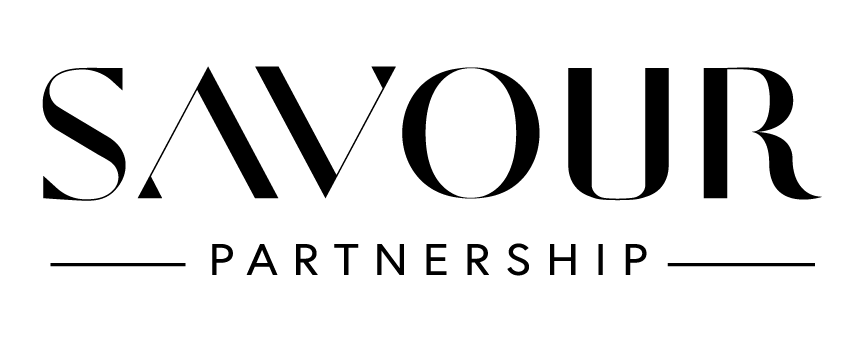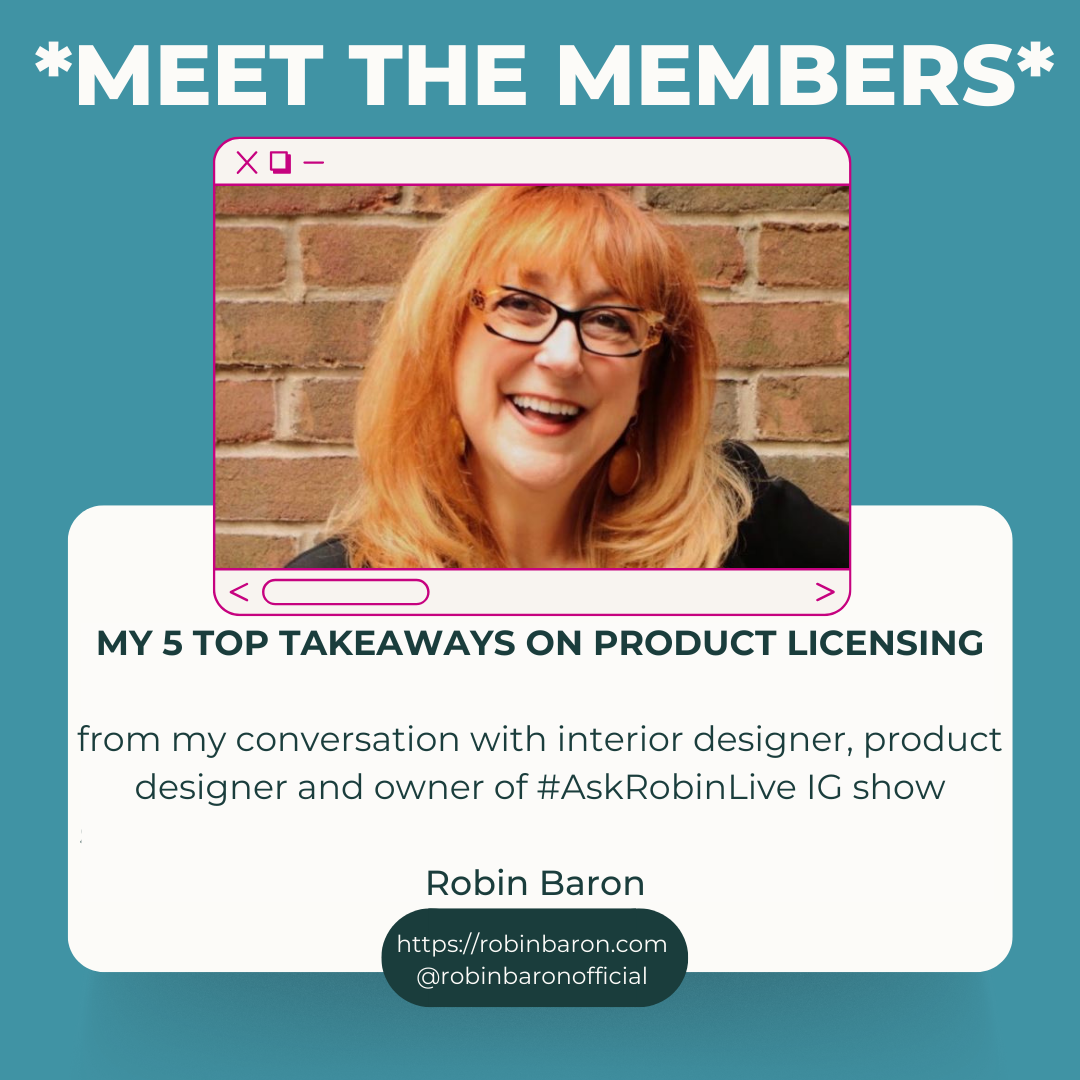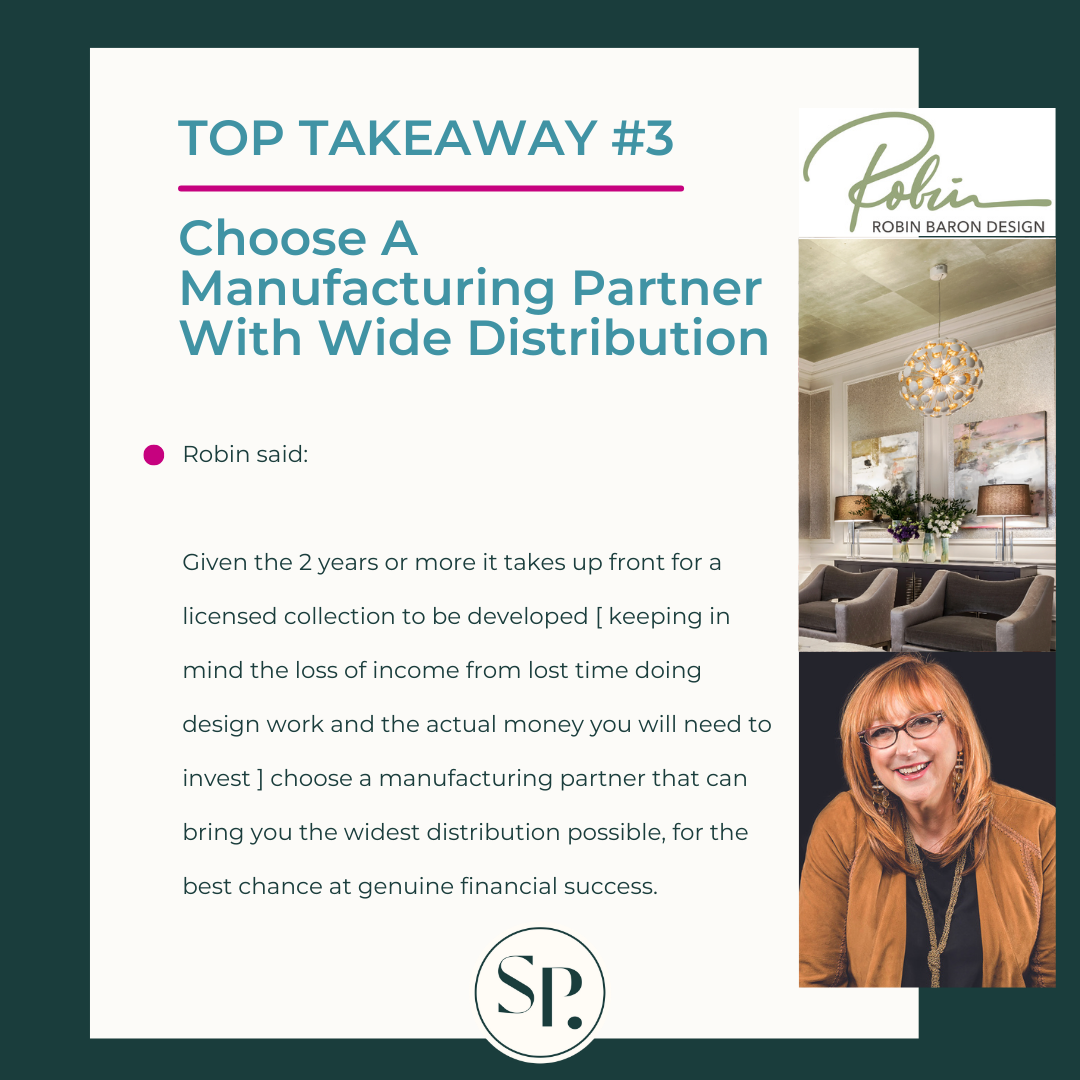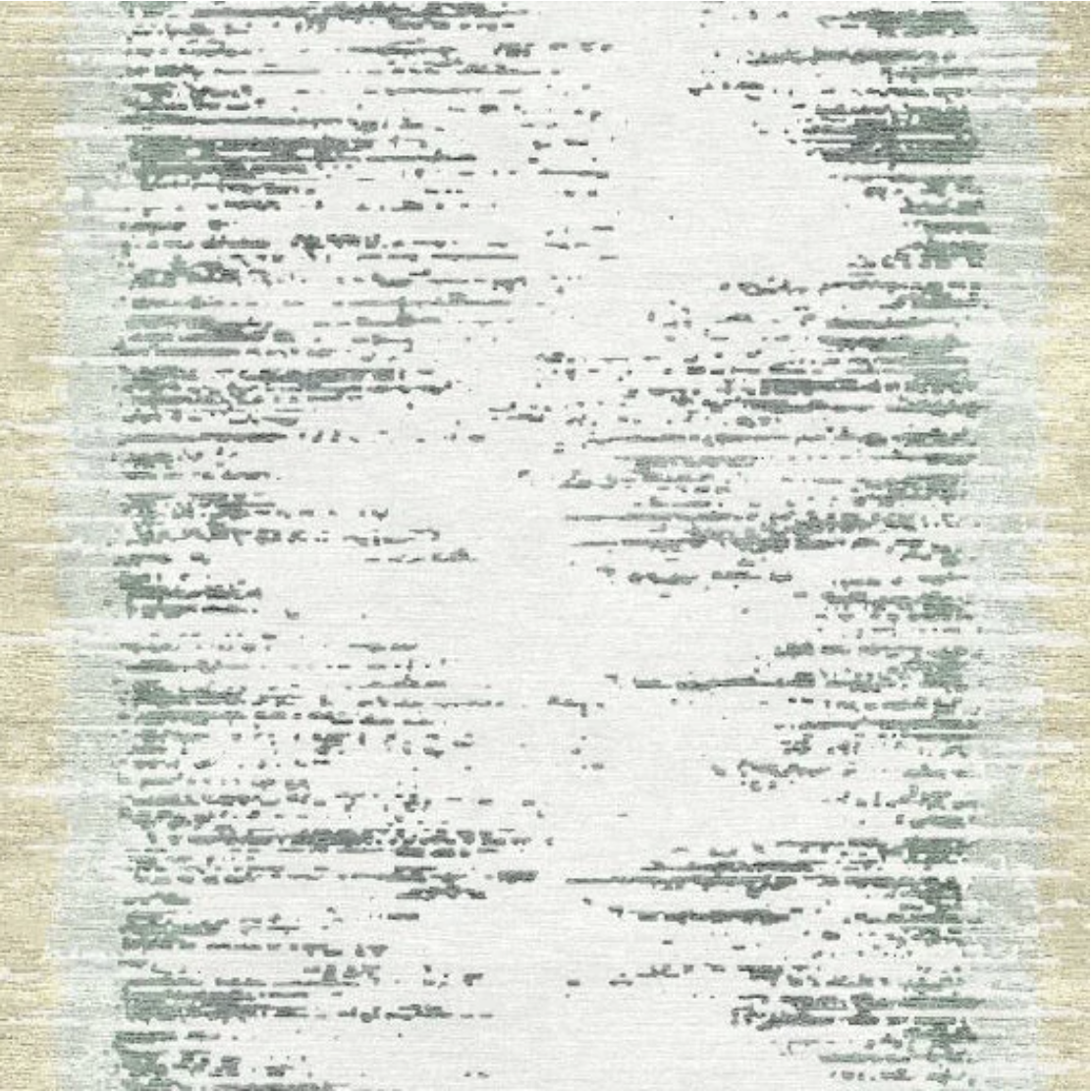Robin Baron: 5 Top Takeaways On Product Licensing
Licensing With Robin Baron
I was so happy to have New York City based interior designer, product designer and the owner of the #AskRobinLive IG show, Robin Baron, join me as my most recent guest speaker on Meet The Members, discussing licensing. Robin has 2 licensed collections currently, and is in development on a 3rd now.
For those of you not familiar with Meet The Members, it is an exclusive opportunity for members of my Facebook Group community for interior designers, #DesignWealth, to meet my guests live on Zoom, every Saturday morning at 9:30 am CT, and ask my guests their questions.
What follows are my own top five takeaways from my/our conversation with Robin, with a bonus takeaway at the end.
Are You Ready To Learn A Lot Of Valuable Information?
Top Takeaway #1: Identify The Holes In The The Manufacturer’s Product Lineup.
Robin stressed that one of the keys in getting a licensed collection is in identifying a hole [ or several ] in a manufacturer’s current offerings, a hole[s] that your unique design sensibility and point of view could fill.
Holes that, if they licensed a collection from you, would almost certainly result in more sales for them.
Be prepared to show the manufacturer, through your sales presentation, exactly why your unique point of view and all you bring to the table for them can help them increase their sales in…a way they don’t easily have access to on their own.
[ MY NOTE: Almost all manufacturers have in house design teams, or can hire well known product designers with proven track records. Those teams and designers are not generally well known to the public, however, The speciality of in house design teams and product design firms is generally in designing products that will sell well to the higher end mass retailer market, but not to the trade only interior designer market.
This is why having a unique point of view in product design and an ability to get manufacturers access to markets they don’t currently penetrate well on their own is so important ].
For instance, Robin now has a licensed collection with Minka Group. Minka was already extremely well known to lighting showrooms and big box retailers, but they were seeking to reach the designer market , as well.
Robin was able to design a collection for them that filled a hole, at a reasonable price point, that has appeal to both their current customer base of lighting showrooms and to independent interior designers - a new channel of distribution for them that will, over time, increase their sales.
Top Takeaway #2: Developing A Licensed Collection Takes Time and Money - Be Prepared
Robin shared with us how important it is to be prepared for how long it can take to develop a licensed collection, once the agreement has been signed with the manufacturer.
She stressed that not only does working on a licensed collection take time away from your main business of designing interiors [ and therefore money ], but it also takes time away from billable hours from those who are working for you, if they are involved in the process in any way.
She shared that, from beginning to end, the process can take up to 2 years from the point the agreement is signed. You may be asking yourselves, “Why so long?” right about now and this is why.
First, you have to turn in your finished drawings for all the designs in your collection to the senior management team. Often, revisions are needed - either to modify the design to make it more sellable or because the design needs to be changed a bit to make the final price point more appealing.
Once you make those revisions, the drawings then have to receive final approved by senior management. Once that has happened, the drawings are turned over to the production team whose job it is to ensure they can be produced with the currently available machinery and labor.
If the production team determines they can’t be produced, more revisions will have to be made. And if it’s determined that new machinery is desired and needed to produce your designs, that machinery has to be procured or designed and produced. Once that is all done, the raw materials are ordered. Once those are received, production is scheduled and begins.
Once production is completed, prototypes have to be shipped for approval. If they’re not approved, the production process is revised, and the production team goes back to work.
Then, once final prototypes are approved, the collection is produced, and the collection debut is scheduled.
All along the way, your time is needed to discuss, answer emails, revise drawings and meet with the various members of the management and production teams.
As you can see, designing a licensed collection is time and money intensive, and not a business direction to be decided upon lightly.
Top Takeaway #3: Choose A Manufacturing Partner With Wide Distribution
Robin stressed that she now seeks manufacturing partners for her licensed collections that have broad mass distribution, like Minka Group.
She shared that she originally thought licensing with the boutique, trade friendly brands she specified in her luxury design work was the way to go, but later realized later that those brands were not her ideal partners for this part of her business.
Why? Because the financial returns Robin desired, for the time and money she needed to invest up front, would never be as large with the boutique brands, as it would be with brands who sold through multiple channels of distribution that reached a larger portion of the buying public.
[ MY NOTE: Licensing with smaller boutique brands can still be very good for personal branding purposes, often leading to other larger opportunities. But, if the strongest possible financial return is your goal, licensing with brands with extensive distribution and appeal to a larger market will yield a better financial result, over time, if the product is right and if it is marketed properly. ]
See most of Robin’s designs for Minka Group lighting below and read more about this collection on the link at the end of this post.
Top Takeaway #4: The Financial Success Of A Licensed Collections Is Not In Your Control
Robin discussed how the ultimate financial success of a licensed collection is not in your control. Why? Because the success of your licensed collection lies with the sales cycle and other factors.
With respect to the sales cycle, you are dependent on:
1. The desire/time and ability of the mfg.’s sales reps to sell it to through their customers.
2. The sales rep’s customers [whether retailers or designers] then selling it through to their customers/clients.
3. The repeat sales orders from designers and/or retailers, which shows the mfg. that the collection has caught on and is worth keeping as part of the lineup.
In addition, various factors can impact the success of your collection that have nothing to do with you. Sales of your collection could be going great, but then the mfg. decides to change direction, the owners decide to retire and sell the business, or market forces come into play: a new competitor copies for a lower price, the market gets weak and the mfg. has to cut all but their very best selling products from the lineup, etc.
Licensing is a gamble, in other words, and as Robin stressed again…you have to have the financial and emotional ability to deal with whatever may come - and the desire to take the risk, despite it all.
Can licensing eventually be lucrative? Yes, it can be. But it’s its own business unit within your business… and you have to be ready and able to commit the time, money and human resources to do everything you can on your part to help make it successful, with no guarantees.
Top Takeaway #5: Have Your Lawyer Negotiate And Get Your Agreement In Writing And Signed
Robin stressed how important it is to negotiate the following points:
1. Product Development: product design fee, # of product designs to be delivered, how they are to be delivered, timelines, prototype sign off protocols, etc.
2. Financial - licensing fees and whether or not that percentage changes depending on number of units sold, exactly when they are paid, how they are paid, etc., what happens in worst case scenarios.
3. Marketing - how the launch will be handled, what is expected from both you and the mfg. on an ongoing basis re: social and media coverage, how will rep meetings be handled & how you will be compensated, how many personal appearances are expected and how will you be compensated for those, how will expenses be covered for you and your travelling companions, etc. while at tradeshows, etc.
Many designers aren’t comfortable negotiating because they feel lucky and grateful to have a licensed collection, which is why a lawyer is necessary. [ I can recommend a good lawyer, in NYC, who specializes in licensing contract negotiations for designers - if anyone reading this needs one. ]
Robin stressed that licensing is a business transaction, for both sides, and that designers deserve to be compensated for every aspect of the time they invest, after the 2 years or so of time already invested [generally without much payment ] in getting a collection ready to go to market.
Robin also stressed that the marketing part of your contract is absolutely essential to get in writing because as she said,
”It’s not what you do, it’s what you do with it that matters.”
Bonus Top TIp Takeaway: Developing and Manufacturing Your Own Collection.
When Robin very first decided licensing was a goal she wanted to pursue, she wasn’t able to get a lot of traction with manufacturers as she wasn’t as well known then as she is now.
So, she decided to develop her own product lines to build her national brand recognition. She mentioned that this was an expensive proposition and time consuming, but also one where she made full margin and where she had ultimate control. She advised us to be prepared to consistently invest in online advertising and digital marketing to push the traffic to your website in order to make these sales.
She said her rugs do very well for her. I’ve selected one I particularly love to show you below. These are customizable, wool and silk, reasonably priced and made to order. See more on the link at the bottom of this post.
If you’ve gotten this far in this long post, I thank you, as always. I hope you’ve learned enough from Robin’s generous sharing to decide whether or not licensing is right for your business and your goals.
Here are further links to explore:
More on Robin’s collection with Minka Lighting:
https://www.savourpartnership.com/blog/lighting-inspiration-introducing-robin-baron-x-minka-group
Robin’s entire rug collection
https://robinbarondesign.com/collections/the-robin-baron-collection-rugs
Follow Robin on Instagram here
https://www.instagram.com/robinbaronofficial/
_____
My own requests:
If you’d like to join approx. 1600 of your fellow interior designers around the country who are members of my Facebook Group community, I invite you to send me a Request To Join here:
https://facebook.com/groups/designwealth
Don’t miss my last two three Top Takeaway posts with previous Meet The Members guests, Carla Aston, Veronika Eagleson and Lisa Peck:
Carla Aston: Monetizing Your Website or Blog For 24/7 Income
https://www.savourpartnership.com/blog/2022/6/10/an-interview-with-carla-aston-her-top-takeaways-for-you
Veronika Eagleson: Influencer Marketing
https://www.savourpartnership.com/blog/2022/6/14/5-top-takeaways-on-influencer-marketing-from-veronika-eagleson
Lisa Peck: Growing Your Instagram Following and Acquiring Your Ideal Clients
https://www.savourpartnership.com/blog/2022/6/21/lisa-peck-5-top-takeaways-on-instagram-growth-and-new-client-acquisition
Lastly, I invite you to follow me on Instagram here:
https://instagram.com/lesliemcarothers
and connect with me on LinkedIn here:
https://linkedin.com/in/lesliecarothers.
and to subscribe to this blog so you are the first to get it in your inbox whenever I publish. When you subscribe, you will get my complimentary download which gives you my 10 Top Tips For How To Drive More Traffic To Your Website For 24/7 Revenue Generation.
You won’t want to miss it, I promise it’s worth it.
In Gratitude,
Leslie Carothers
Principal, Savour Partnership
Named One Of HFN Magazine’s Top 40 Most Inspiring Women In Home
2022 Top 200 Influencer In Interior Design
NEWS FLASH! In early September, I will be delivering the keynote speech at the brand new conference, being produced by Furniture Today magazine, The Innovation Event.
See more here: https://theinnovationevent.com . There will be more to come on this and again, thank you for reading. I appreciate each of you!










